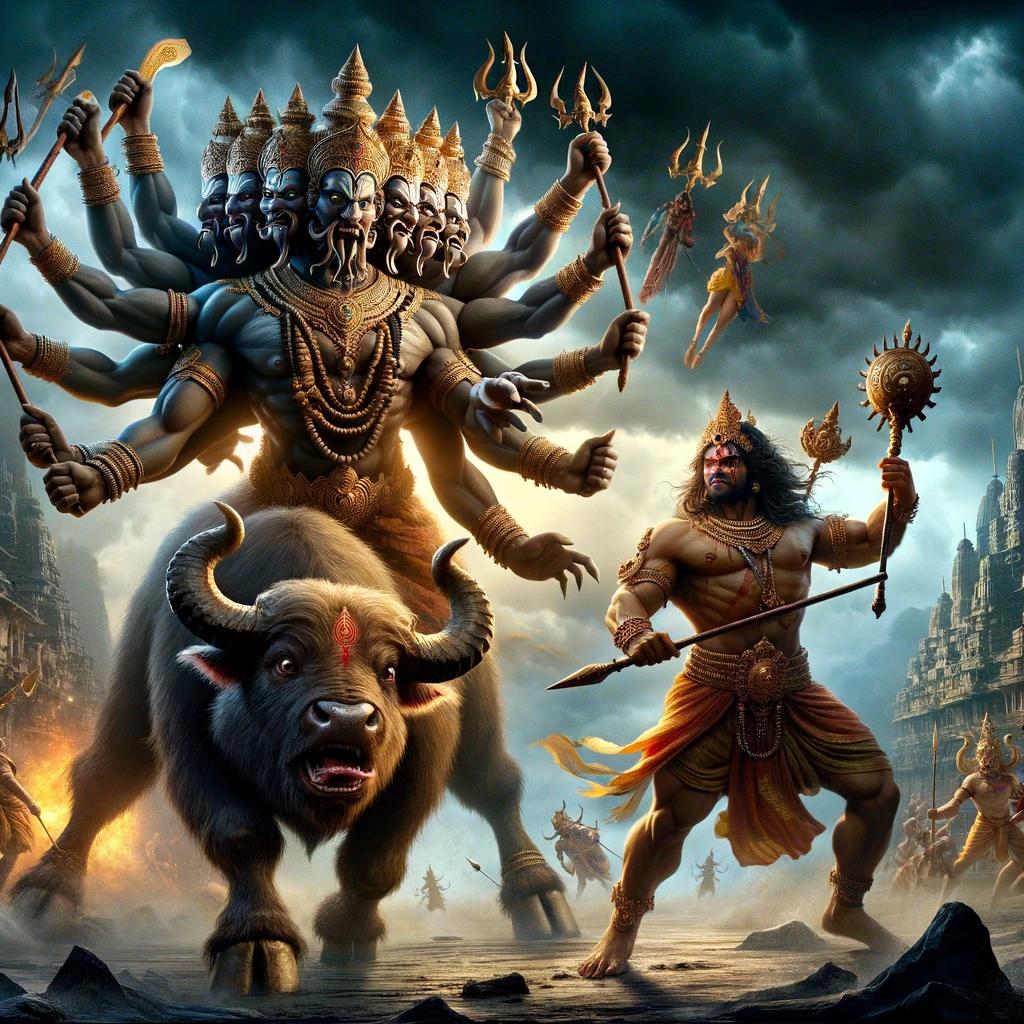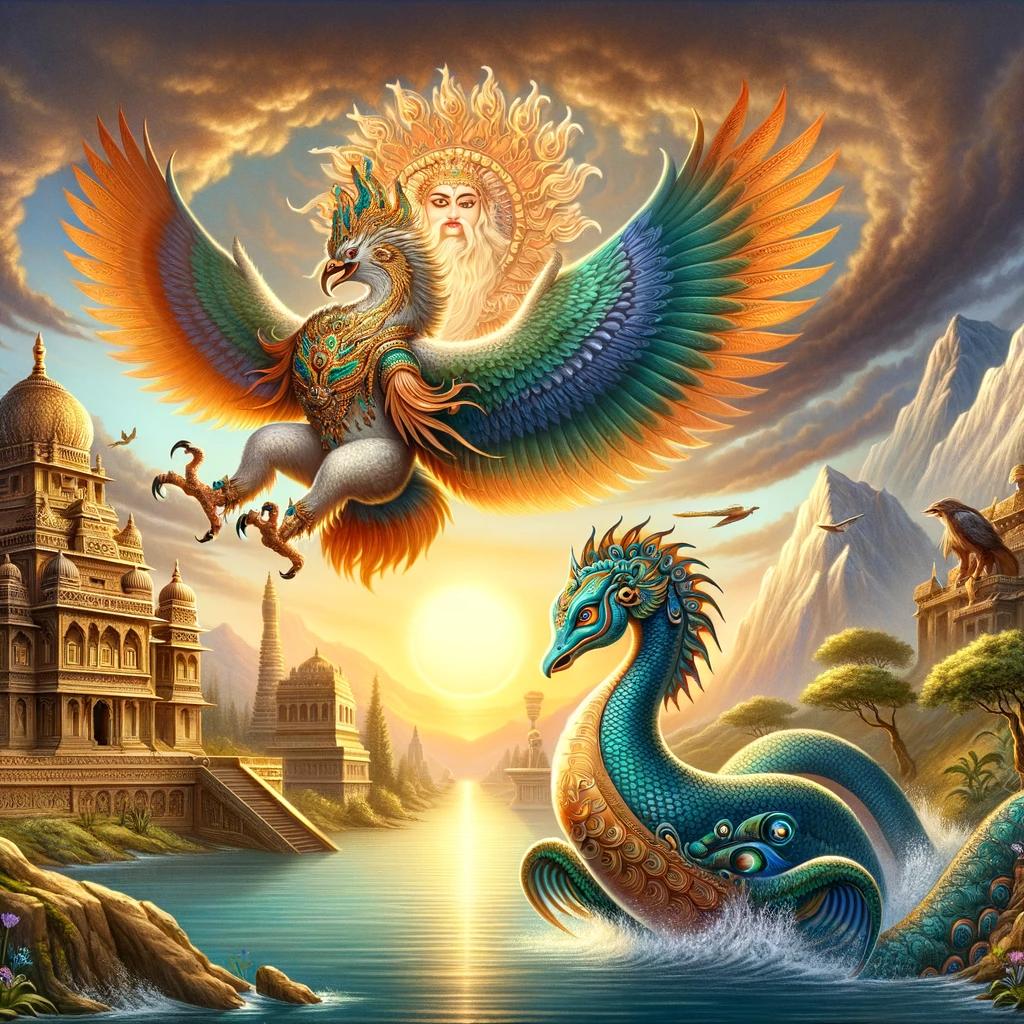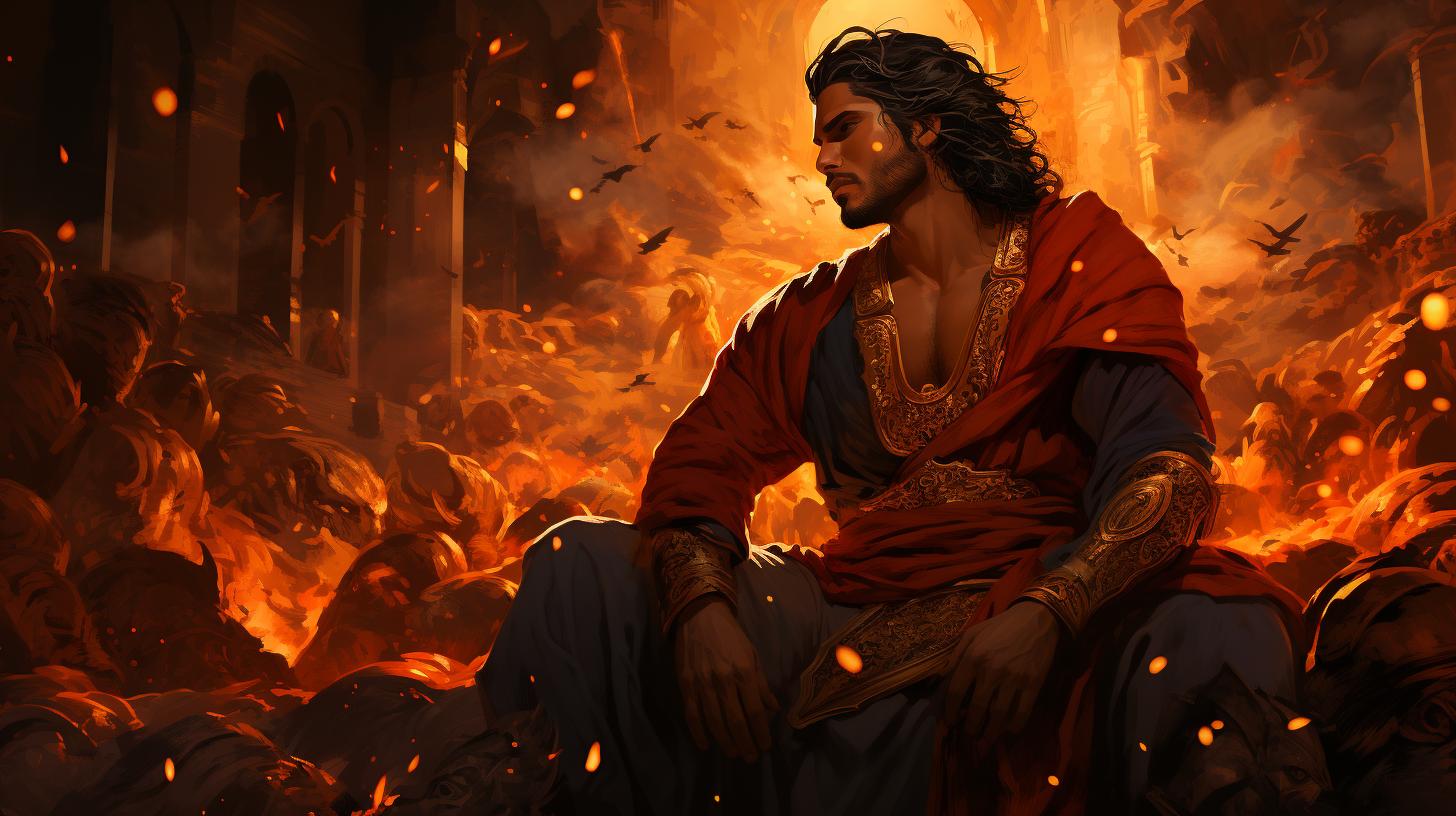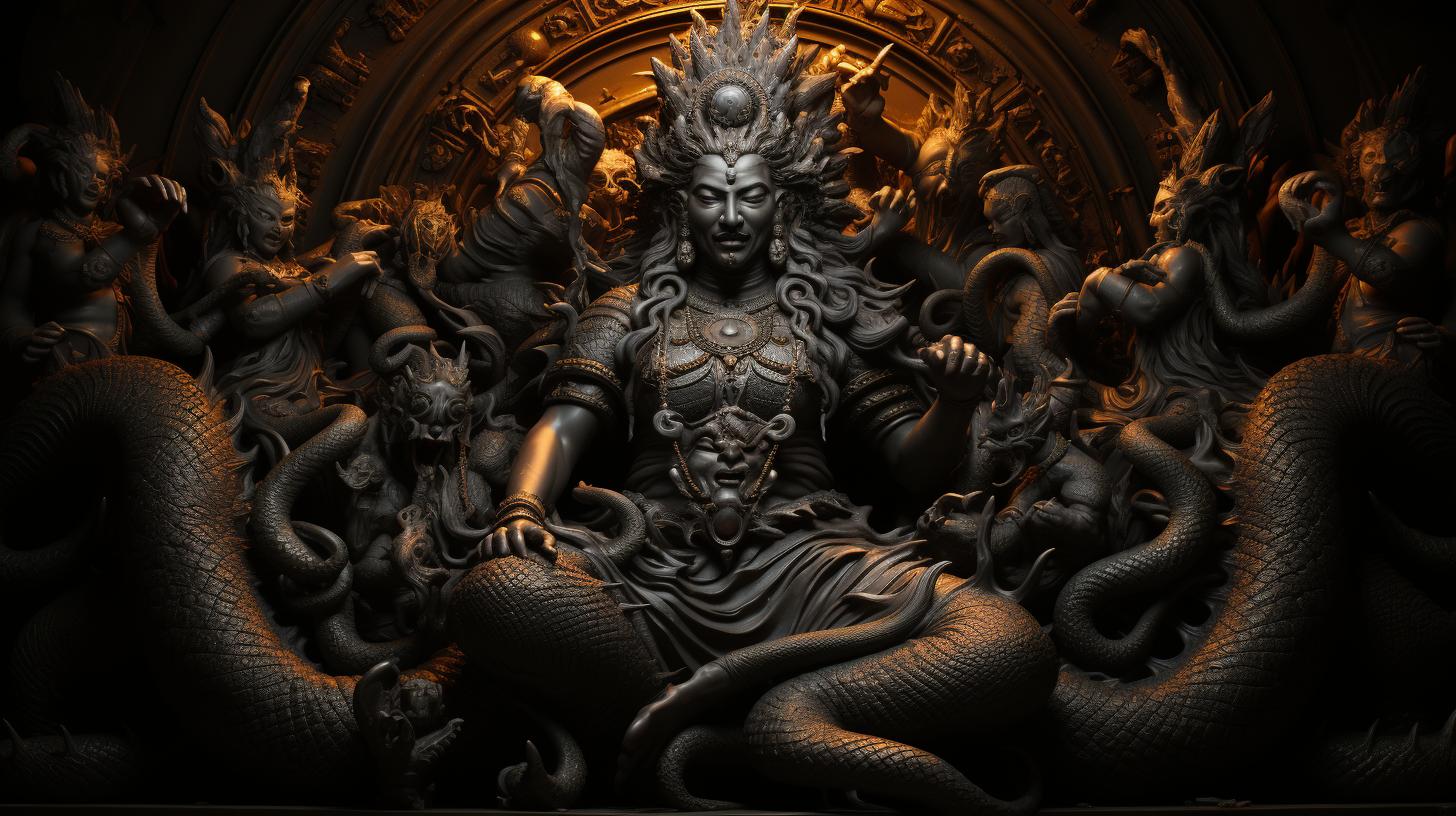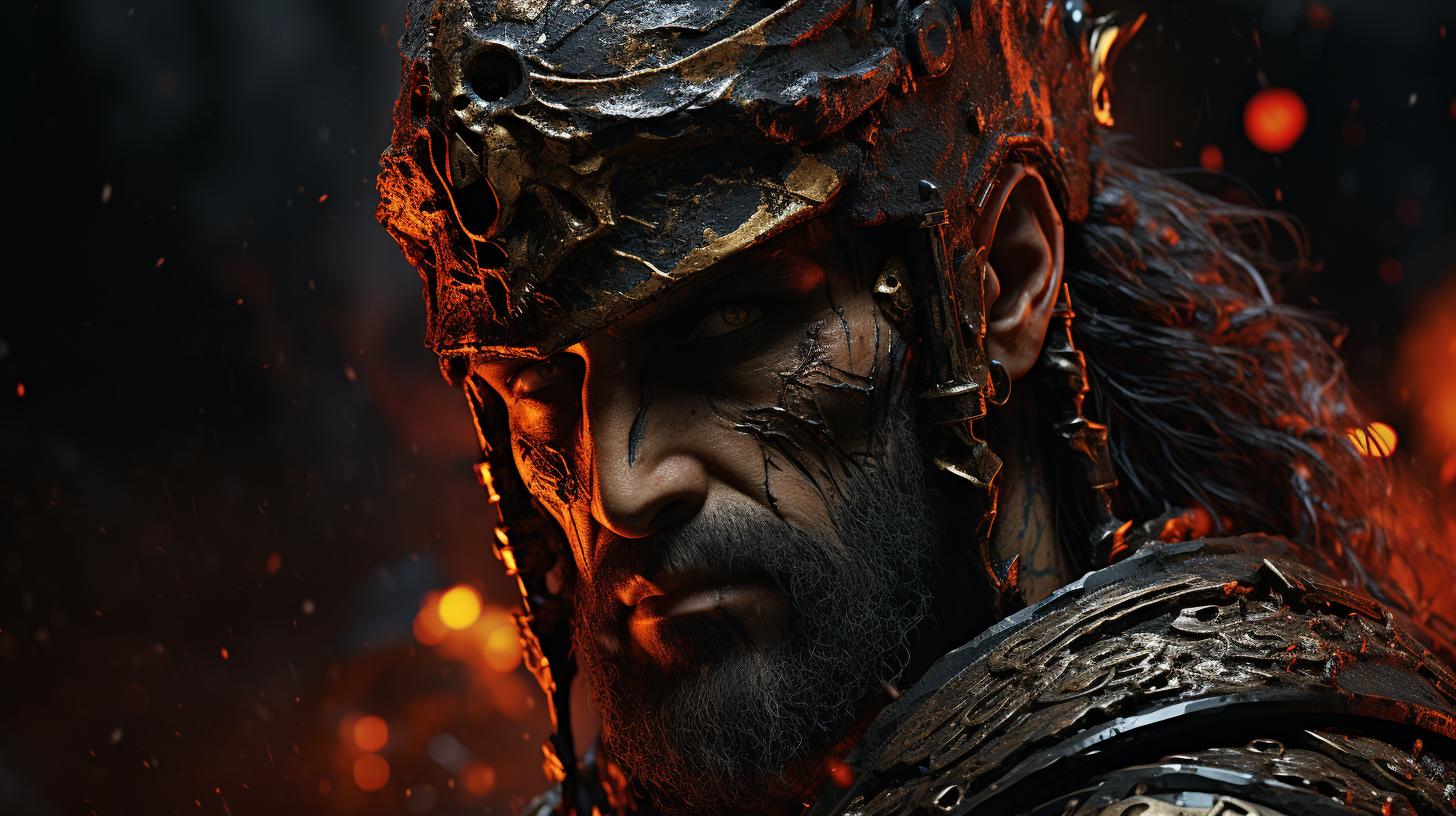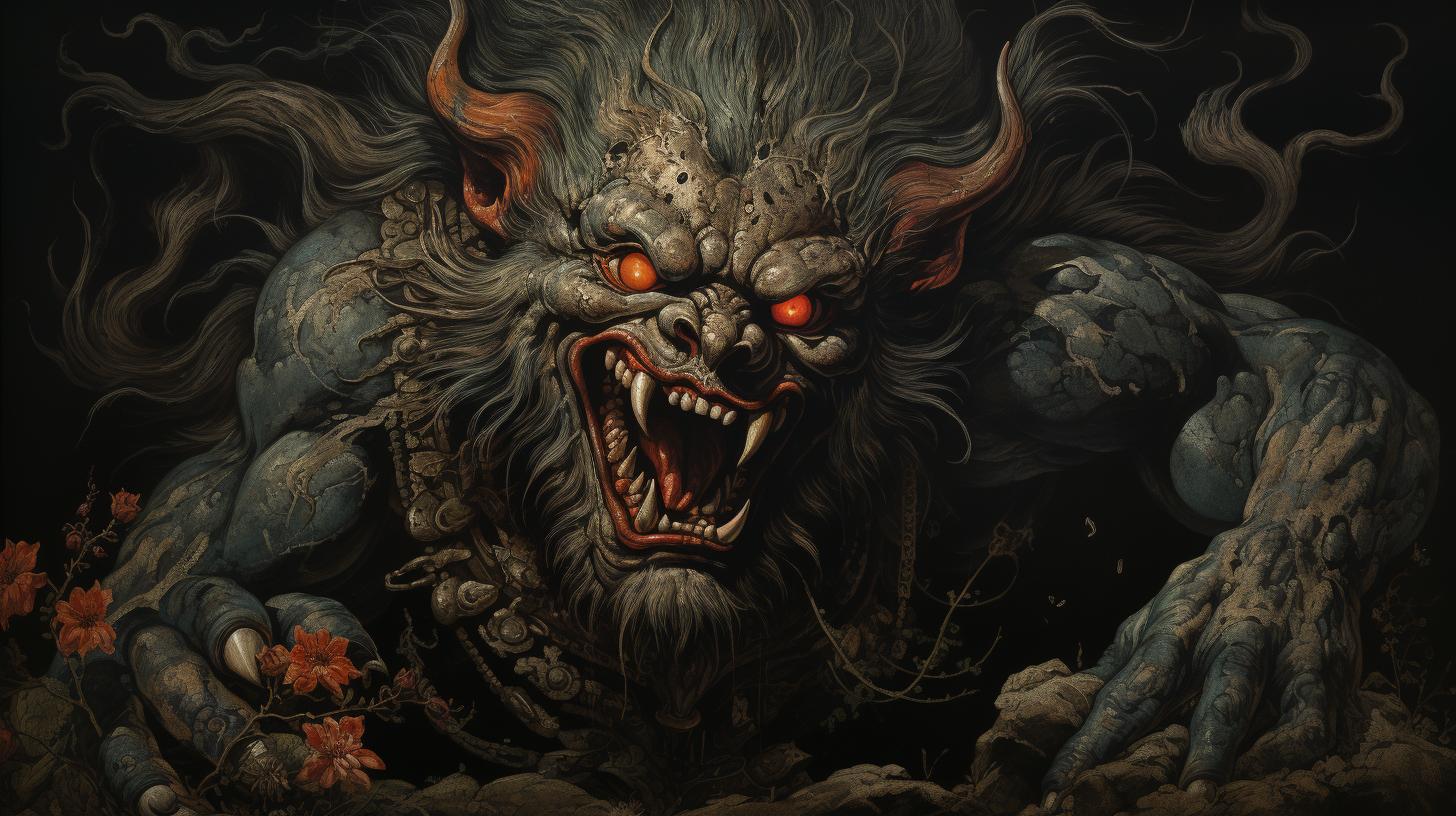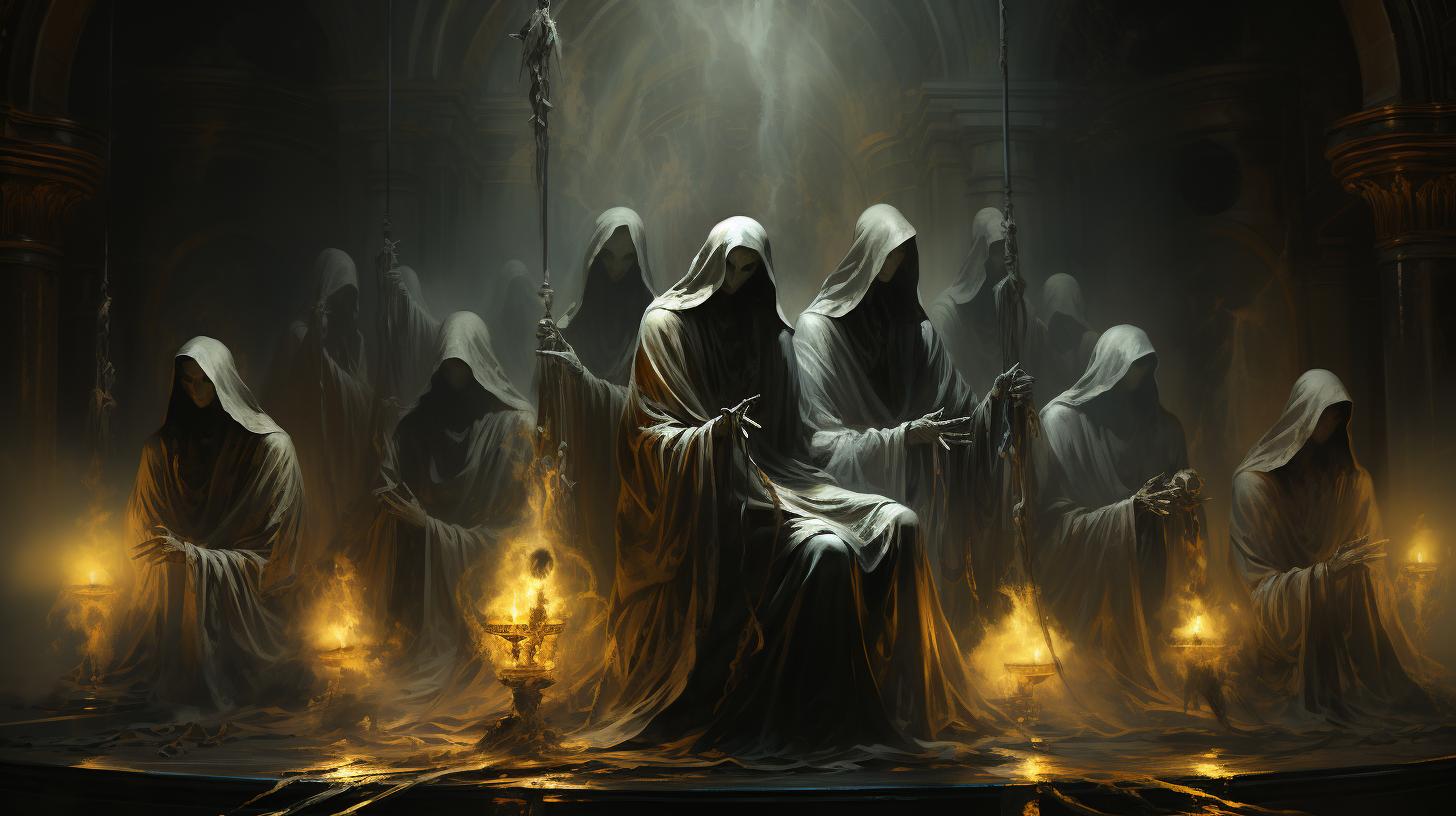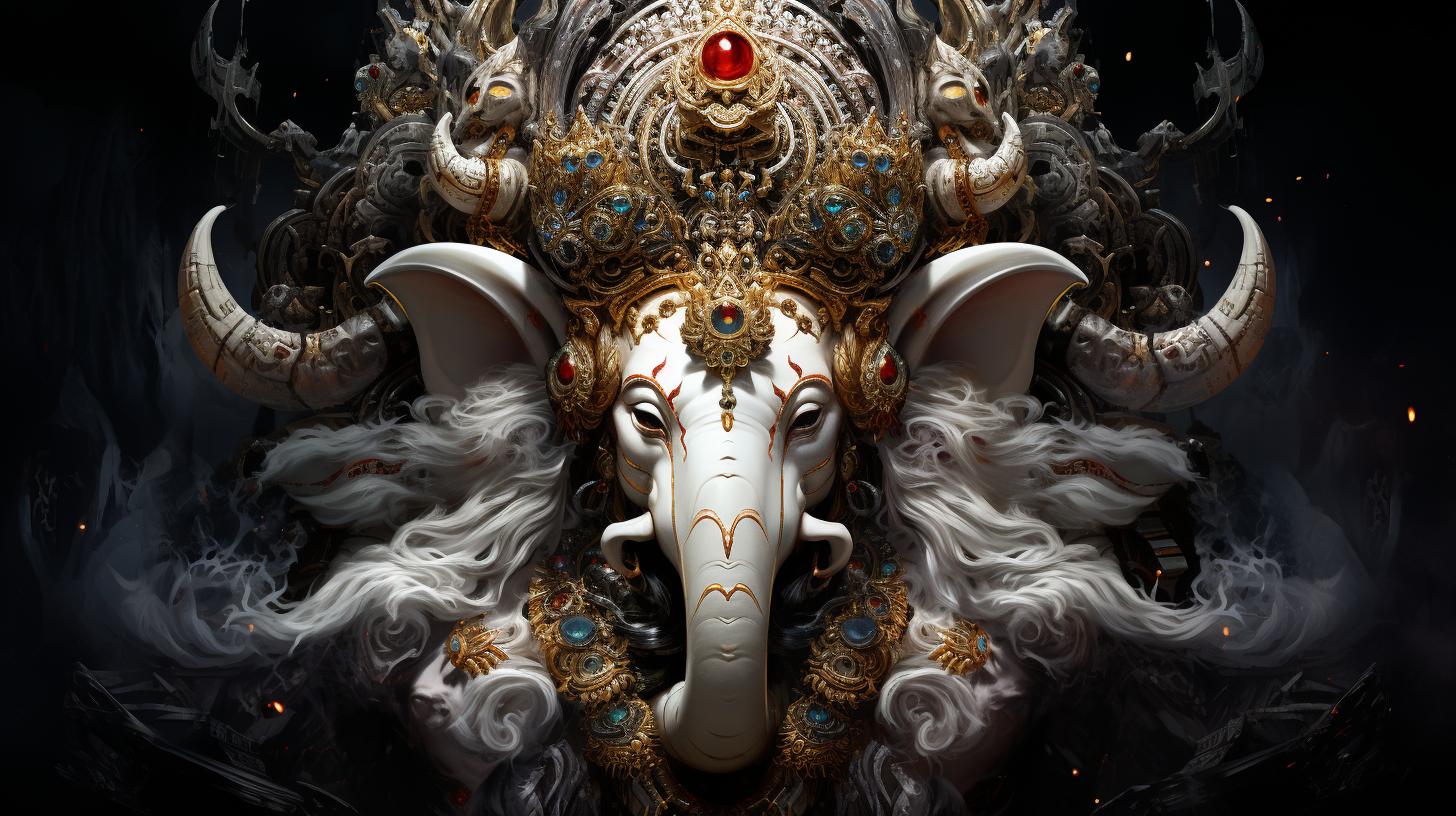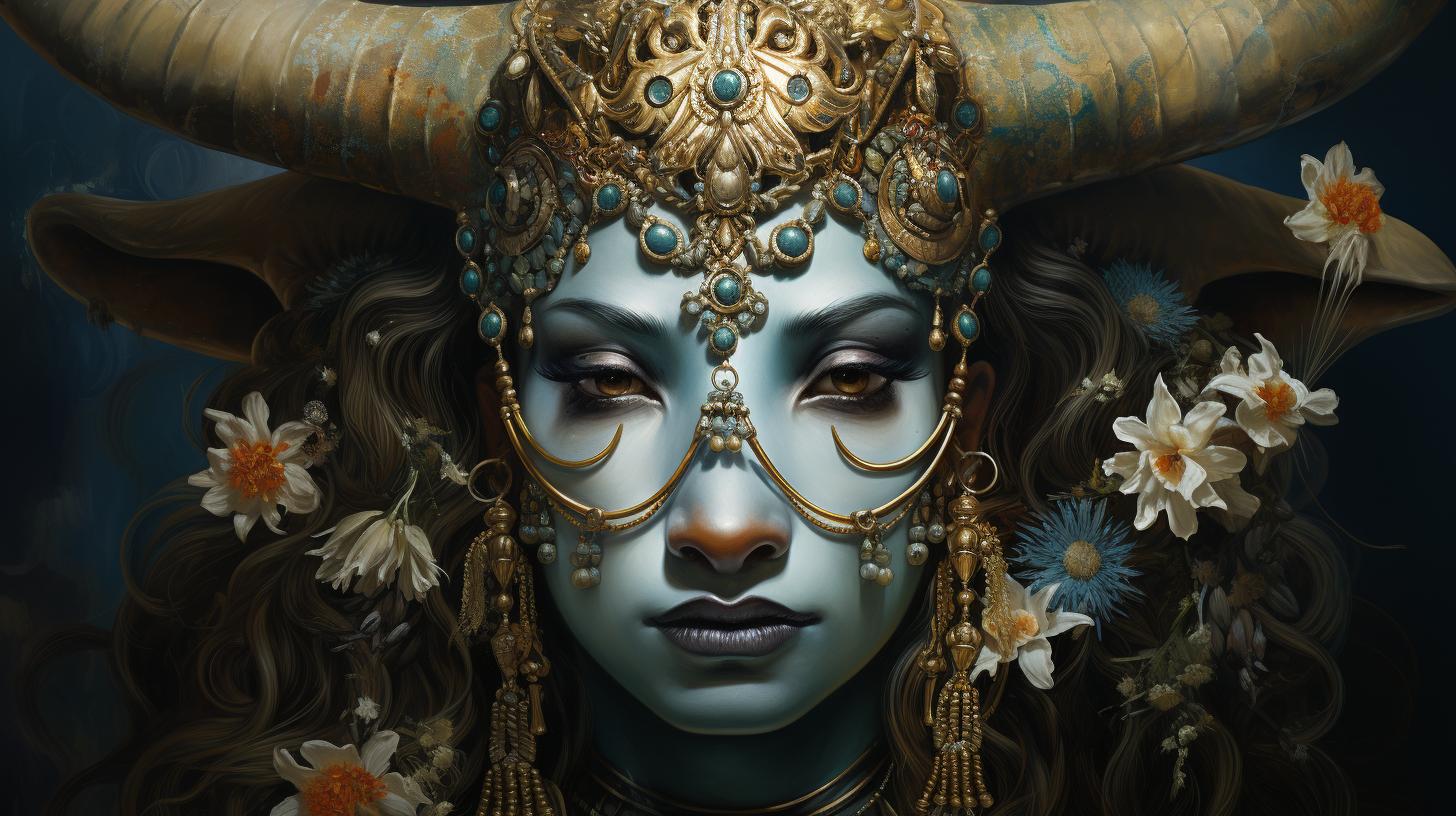Indian Mythology Demons: Exploring the Dark Realm of Hindu Mythology
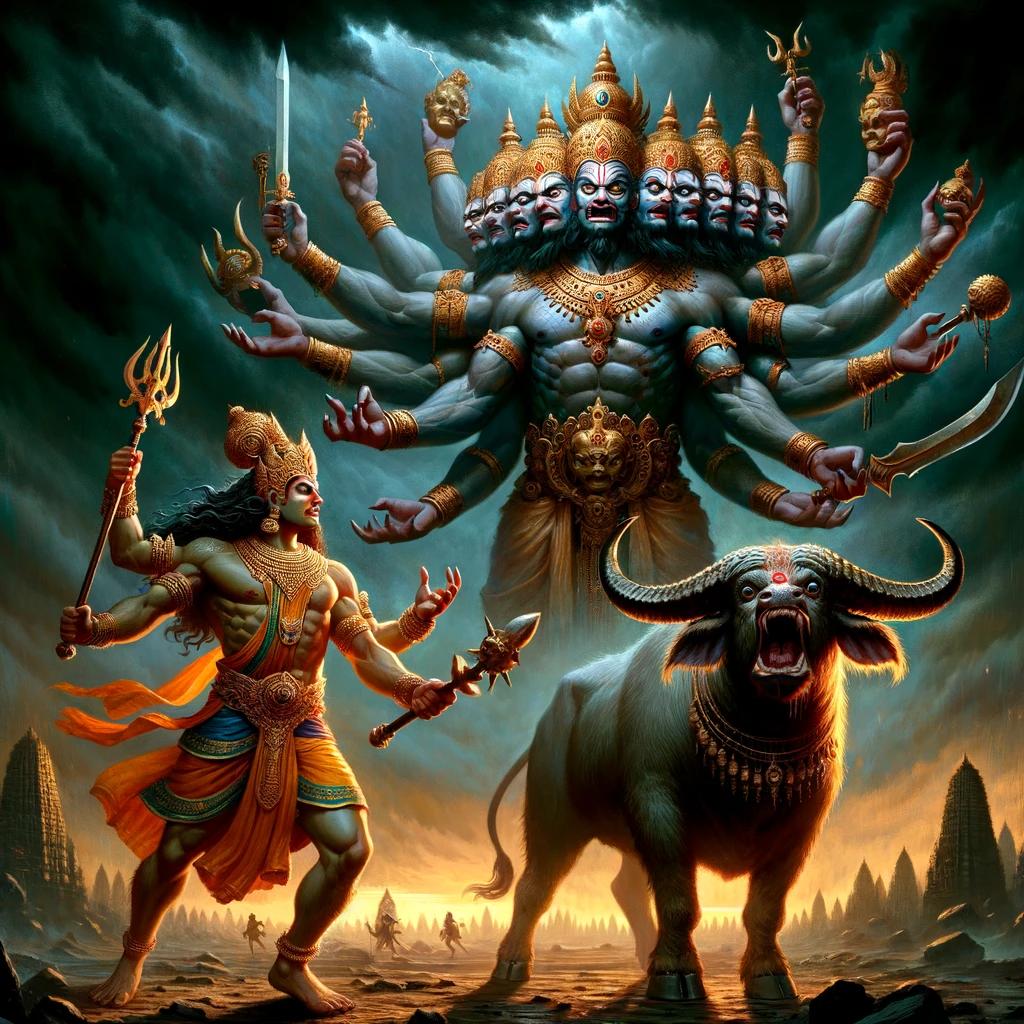
In Hindu mythology, demons play significant roles in the epic narratives and religious beliefs. These powerful beings, known as rakshasas and asuras, oppose the benevolent gods and are associated with acts of evil and cosmic disturbance.
One prominent demon is Ravana, the king of the rakshasas, who engages in an epic battle against Prince Rama. Another notable figure is Kali, a fearsome and destructive goddess.
Alongside Ravana and Kali, various other demons shape the rich tapestry of Indian mythology. Explore the dark world of Indian mythology demons in this article.
The Rakshasas: Evil Creatures in Hindu Mythology
In Hindu mythology, the rakshasas are formidable and malevolent creatures that play a significant role in the tales and beliefs of ancient India. These demonic beings are often portrayed as powerful adversaries to the gods and are known for their evil nature and destructive tendencies.
Rakshasas are depicted as monstrous beings with fearsome appearances, possessing supernatural abilities that they employ to wreak havoc and disrupt the cosmic order. They are distinct from the benevolent deities known as devas and are considered to be asuras, beings driven by a thirst for power and opposed to the devas.
These evil creatures are said to possess the ability to shape-shift, appearing in various forms to deceive and harm their enemies. They are often associated with darkness, chaos, and the consumption of human flesh, adding to their terrifying image.
In Hindu mythology, numerous stories and legends revolve around encounters between rakshasas and gods or heroes. These encounters often involve epic battles and tests of strength, wit, and virtue. The rakshasas’ cunning nature and formidable powers make them formidable adversaries, presenting formidable challenges for the protagonists.
Through their portrayal in Hindu mythology, the rakshasas serve as symbols of evil, representing the constant struggle between good and evil, light and darkness. They highlight the complexities of morality and the eternal fight to maintain cosmic balance.
The Female Rakshasas and their Role in Hindu Mythology
In Hindu mythology, the rakshasas are evil creatures that play significant roles in the cosmic narratives. While commonly depicted as male, the existence of female rakshasas should not be overlooked. These formidable female demons, known as rakshasis, possess their own unique powers and are integral to the intricate tapestry of Hindu mythology.
The rakshasis are portrayed as cunning and seductive beings, capable of transforming their appearances to deceive and manipulate others. They wield their supernatural abilities to wreak havoc, often thwarting the plans of gods and humans alike.
These female demons are associated with destructive forces, representing the darker aspects of femininity in Hindu mythology.
One prominent example of a rakshasi is Shurpanakha, a pivotal character in the epic Ramayana.
Shurpanakha, the sister of Ravana, is depicted as a captivating yet malevolent figure. Her encounter with Prince Rama and his brother Lakshmana sets in motion a chain of events that ultimately leads to the epic battle between Rama and Ravana. Shurpanakha’s role highlights the significant influence and power that female rakshasas possess within the mythological realm.
Aside from Shurpanakha, other female rakshasas, such as Simhika and Khara’s sister, are mentioned in various Hindu mythological texts. While their appearances may be brief, their impact on the overall narrative is substantial, as they contribute to the dynamic interplay between good and evil forces.
The inclusion of female rakshasas in Hindu mythology underscores the complex nature of gender and power dynamics within the mythological framework. These female demons challenge traditional notions of femininity, embodying both beauty and malevolence.
Their presence serves as a reminder that evil and destructive forces can manifest in various forms, transcending gender boundaries.
Exploring the role of female rakshasas in Hindu mythology provides a deeper understanding of the intricate cosmology and the multifaceted characters that populate this ancient tradition.
By delving into the stories and symbolism surrounding these female demons, we gain valuable insights into the rich tapestry of Indian mythology and the complexities of the human experience.
Asuras: The Hindu Demon Gods
In Hindu mythology, alongside the rakshasas, there exist powerful demon gods known as asuras.
These asuras are distinct from the benevolent devas and are constantly seeking power and control, opposing the divine forces. Asuras possess incredible strength, mystical abilities, and engage in epic battles with the gods.
The asuras are often depicted as formidable rivals to the devas, challenging their authority and attempting to seize control of the cosmic order. In their pursuit of power, some asuras even managed to gain boons and immortality, making them virtually invincible in battles.
Examples of such asuras include Mahishasura, who received the boon of invincibility, and Vritra, who held the ability to engulf the waters of the world.
However, not all asuras are purely malevolent.
Some are characterized as complex beings with both virtues and flaws. Despite their demonic nature, some asuras possess noble qualities and are capable of acts of righteousness. This duality within their character adds depth to the mythological narratives and challenges the simplistic notions of good and evil.
The portrayal of asuras in Hindu mythology serves as a reminder of the eternal struggle between light and darkness, embodying the complex nature of human existence and the constant battle between opposing forces.
Ravana: The Powerful Demon King of Hindu Mythology
Ravana, the legendary demon king in Hindu mythology, is a central character in the epic Ramayana. Known for his immense power and influence, Ravana was not an ordinary demon but a rakshasa of extraordinary strength and intelligence.
He was depicted with ten heads and twenty arms, symbolizing his superiority over mortals and gods alike.
As the ruler of Lanka, a mighty fortress located on an island, Ravana wreaked havoc and caused unrest in the cosmic order.
His most infamous act was the abduction of Sita, the wife of Prince Rama. This act of aggression sparked an epic battle between Rama and Ravana, symbolizing the eternal struggle between good and evil.
Despite his demonic nature, Ravana was a complex character with both virtues and flaws. He was a learned scholar, a devoted follower of Lord Shiva, and an accomplished musician.
However, his thirst for power and his arrogance led to his downfall.
In the climactic battle, Rama, aided by the monkey army led by Hanuman, fought against Ravana and his formidable forces.
After a fierce struggle, Rama emerged victorious, ultimately slaying Ravana and restoring the balance of cosmic harmony.
The story of Ravana serves as a moral lesson, highlighting the consequences of hubris and the importance of righteousness.
Despite his demonic nature, Ravana’s character represents the intricacies of human emotions and the constant battle between good and evil within oneself.
The Epic Battle of Rama and Ravana
The story of Rama and Ravana is one of the most iconic and significant tales in Hindu mythology.
This epic battle is a central theme in the ancient Indian epic, Ramayana. It revolves around the heroic prince Rama and the powerful demon king Ravana.
Ravana, with his ten heads and twenty arms, ruled over the kingdom of Lanka and was known for his immense power and supernatural abilities.
He was enamored by the beauty of Rama’s wife, Sita, and abducted her, resulting in a quest for vengeance by Rama.
Rama, accompanied by his loyal allies, including the monkey-god Hanuman, embarked on a perilous journey to rescue Sita and defeat Ravana. The battle between these two formidable opponents was fierce and intense, filled with extraordinary displays of strength and skill.
Rama’s unwavering devotion to righteousness, coupled with his divine weapons and the assistance of gods, ultimately gave him the upper hand. With his powerful bow, Rama shot arrows that pierced through Ravana’s multiple heads, weakening him and eventually leading to his demise.
The epic battle of Rama and Ravana symbolizes the triumph of good over evil, righteousness over wickedness. It showcases the importance of courage, valor, and an unwavering commitment to upholding dharma, the moral and ethical principles in Hinduism.
This monumental battle is celebrated annually during the festival of Dussehra in India, where effigies of Ravana are set ablaze, signifying the victory of good and the vanquishing of evil.
Kali: The Destructive Goddess in Hindu Mythology
In Hindu mythology, Kali is a formidable goddess associated with destruction and chaos. She is depicted as a fearsome figure with multiple arms and a protruding tongue. Kali is often portrayed in a violent and aggressive manner, wielding various weapons and adorned with severed heads and a girdle of human hands.
Kali’s destructive nature is closely linked to her role as a goddess of time, representing the unstoppable force of death and transformation. She is considered the ultimate destroyer of evil and ignorance, fiercely challenging the established order to bring about the renewal and liberation of the soul.
Although Kali may seem menacing, she is also revered as a protective deity, especially by those seeking liberation from worldly attachments. Devotees believe that by worshipping and surrendering to Kali, they can overcome their inner demons and attain spiritual enlightenment.
Kali is often associated with rituals involving blood sacrifice and cult practices, symbolizing the breaking of societal norms and unleashing primal energy. Her worshipers engage in fierce and intense rituals to invoke her powers and seek her blessings.
It is important to note that Kali’s destructive aspect should not be misunderstood as purely malevolent. In Hindu mythology, destruction is seen as a necessary and transformative force, paving the way for new beginnings and spiritual growth.
Kali embodies this profound symbolism, challenging conventional notions of good and evil.
In conclusion, Kali, the destructive goddess of Hindu mythology, holds a significant place in the pantheon of deities. Her fierce and formidable persona embodies the forces of destruction and transformation, playing a crucial role in the cycles of life and death.
Other Prominent Demons in Indian Mythology
Indian mythology is replete with a myriad of demons and malevolent beings that contribute to the rich tapestry of Hindu folklore. These formidable creatures, known as asuras and rakshasas, exhibit extraordinary powers and engage in epic battles against the forces of good.
Let’s explore some of the notable demons in Indian mythology:
Andhaka: The Merciless Asura
Andhaka, a ruthless asura, is depicted with thousands of eyes, heads, and arms. He symbolizes the relentless pursuit of power and challenges the devas, the benevolent gods, in their quest to maintain cosmic order.
Arunasura: The Invincible Asura
Arunasura, a potent asura, possesses the boon of invincibility in battle. This formidable adversary constantly tests the devas’ strength and resilience, making him a formidable presence in Hindu mythology.
Bakasura: The Terrifying Rakshasa
Bakasura, a horrifying rakshasa, terrorizes a kingdom by devouring its citizens.
This monstrous demon strikes fear into the hearts of all who encounter him, embodying the destructive forces in Hindu mythology.
Bali Raj: The Exiled Daitya King
Bali Raj, a daitya king, was banished by the god Vishnu. Despite his exile, Bali Raj displays immense power and leadership qualities. His story serves as a reminder of the complex dynamics and conflicts within the Hindu mythological realm.
Bhuta: Supernatural Beings Associated with Ghosts
Bhutas are supernatural entities closely associated with ghosts and restless spirits. These malevolent beings bring forth fear and chaos, contributing to the intricate web of mythical creatures in Hindu folklore.
Kabandha: The Cursed Rakshasa
Kabandha, a rakshasa cursed by a sage, takes on a grotesque and carnivorous form.
His story serves as a cautionary tale of the consequences of misdeeds and the transformative nature of curses in Hindu mythology.
Kumbhkarna: The Virtuous Demon Brother of Ravana
Kumbhkarna, the younger brother of Ravana, possesses great virtues and is a skilled warrior. Despite being on the side of evil for a significant part of his life, his character highlights the nuanced nature of Hindu mythology and the potential for redemption.
Maricha: Ravana’s Ally in the Kidnapping of Sita
Maricha, a demon allied with Ravana, plays a key role in the abduction of Sita, Prince Rama’s wife. His involvement in this epic event highlights the multifaceted nature of characters in Hindu mythology and their complex motivations.
Puloman: The Asura King of the Subterranean Realm
Puloman, an asura king, rules over the subterranean realm known as Patala. His dominion underscores the diverse realms and dimensions present in Hindu mythology, expanding the scope of the mythical universe.
Rakshasas: Semidivine Man-eaters in Hindu Mythology
The rakshasas, a powerful race of semidivine man-eaters, were created by Brahma to protect the primordial waters. These fearsome creatures embody the darker aspects of Hindu mythology and are notorious for their insatiable appetite for human flesh.
Through these prominent demons in Indian mythology, we gain a deeper understanding of the diverse and intricately woven tapestry of Hindu folklore. Each demon represents unique virtues, flaws, and motivations, contributing to the complex interplay between good and evil within this rich mythological tradition.
Exploring the Complex Nature of Hindu Mythology’s Demons
In Hindu mythology, the demons of Indian folklore are not mere embodiments of pure evil. Rather, they possess a complexity that goes beyond their malevolent actions. These demons, such as Ravana, Kali, and the numerous asuras and rakshasas, offer a deeper understanding of the intricate nature of good and evil within the Hindu belief system.
Unlike gods and goddesses who represent benevolence, demons challenge the established order and seek power for themselves. However, their portrayal is not one-dimensional, as Hindu mythology delves into their virtues, motivations, and internal struggles.
This exploration of the complex nature of demons provides a nuanced perspective on the concepts of morality and duality in Hindu mythology.
Ravana, for instance, while portrayed as a powerful and malevolent demon king, also possesses virtues such as intelligence, knowledge, and devotion to Lord Shiva. His character highlights the intricacies of human nature and the blurred lines between good and evil.
Similarly, Kali, the goddess of destruction, embodies both terrifying aspects and profound symbolism, representing the transformative power of destruction.
The asuras and rakshasas mentioned in the Hindu texts further exemplify this complexity.
They are not purely villains but often have their own justifications and grievances. These demons are also known for their extraordinary abilities and prowess in battle, challenging the gods themselves and pushing the boundaries of cosmic order.
Exploring the complex nature of Hindu mythology’s demons allows us to recognize the multifaceted portrayal of good and evil within this ancient belief system. It invites us to contemplate the blurred boundaries between light and darkness, virtue and vice, and the profound philosophical questions raised by these intricate characters.











